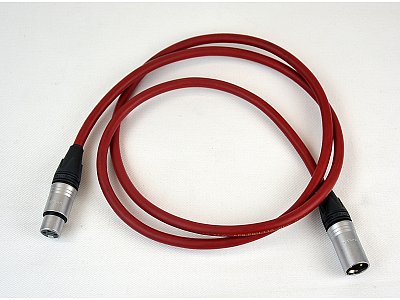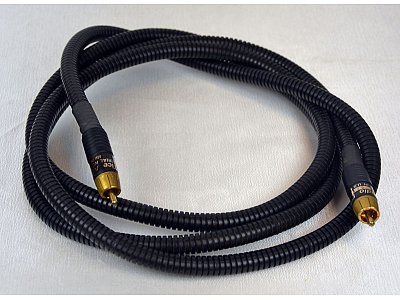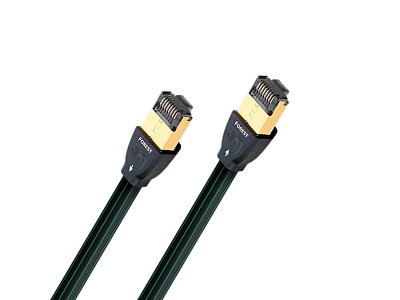VAN DEN HUL THE DIGI-COUPLER 75 OHM
Digital audio interconnect cable
9 review/sCode: 76942782
All our products are covered by Italian warranty.
The DIGI-COUPLER 75 ? is our top level SPDIF digital audio interconnect cable, though is equally suited for Video and HF signal transport at a maximum performance level.
The DIGI-COUPLER 75 ? has been specially designed bearing the highest possible transmission quality of 75 ? impedance level SPDIF consumer format digital audio in mind, and is aimed at the critical audiophile as well as the professional.
The DIGI-COUPLER 75 Ohm???s special design covers all aspects required for a flawless and reliable transmission of SPDIF digital audio at short range as well as across large studio distances and allows for notable improvements in your audio quality.The cable???s strict HF design likewise benefits the transport of Video and HF signals well into the GigaHertz range.
Features:
The DIGI-COUPLER 75 ? features a very constant and precise 75 ? impedance: 75 ? ± 0.5 ? up to 3 GHz. This is important, since otherwise the signal will be reflected up and down the cable (i.e. standing waves). Such signal reflections deteriorate signal integrity by causing the digital audio signal as seen at the receiving end to be overlapped with time delayed replicas of itself (i.e. signal reflection induced inter-symbol interference).At the receiving side this negatively influences the D-to-A converter clock retrieval circuitry???s (PLL???s) ability to maintain a stable sample rate (i.e. fluctuations in the timing interval between the audio signal???s samples occur). The resulting distortion of the audio signal is officially called ???jitter distortion??? and is particularly perceivable as reduced resolution and imaging.
Note: To maintain a precise 75 ? impedance and avoid signal reflections, the advised minimum value of bending radius for The DIGI-COUPLER 75 ? is 8.0 cm.
The DIGI-COUPLER 75 ? features a very high frequency bandwidth.As an example: The -3 dB bandwidth of a 10 m. run is 770 MHz. (For more data see Attenuation graph in the sidebar)
A high bandwidth is important: An SPDIF digital audio signal contains frequencies that extend far beyond the usually specified minimum required bandwidth (~6 MHz). Even though this minimum bandwidth provides useable transmission, accurate data transmission and recovery of low-jitter clocks in real-world noisy environments will benefit from greatly increased bandwidth:
The digital audio signal consists of elementary data units (bits) in the form of zeros and ones. These are square waves (merlon shaped elements) which vertical edges serve as a demarcation for the signal receiving circuitry (e.g. D-to-A converter) to be able to retrieve the signal clock and to recognise the contained bit values.
Cable bandwidth decreases with cable length used. Lower bandwidths increasingly cause the digital audio signal???s square waves edges to get rounded off and become smeared over time (inter-symbol interference). This impairs the receiving circuitry???s ability to correctly determine the individual bit values and their timing. The so-called ???jitter distortion??? and ???bit error rate??? increase and the audio quality decreases. A short note regarding optical fiber cables for digital audio and bandwidth: Although these exhibit a very high bandwidth and near perfect noise immunity by themselves, the bandwidth of the unavoidably extra involved optical transmitter and receiver parts (especially those used in common consumer devices) is one of the most important performance limiting factors. Others are: The optical power available, so-called modal dispersion, attenuation and connector transition losses. Depending on the situation, though in many cases, coaxial SPDIF transfer is preferable if low jitter distortion replay is aimed at. This provided a good cable like our The DIGI-COUPLER 75 ? is used... The DIGI-COUPLER 75 ? features a very low signal attenuation per unit length. As an example: At 100 MHz the attenuation is a mere 0.11 dB/m. (For more data see HF Performance Graphs in the sidebar).
Low signal attenuation (i.e. low signal loss) is especially important when long cable runs are used (e.g. in professional / studio applications).To maintain optimum signal quality, a maximum signal to noise ratio at the signal receiving side is required. The signal therefore needs to undergo as little as possible attenuation during transport. This of course equally applies to digital audio as to video and HF signals.A low signal attenuation also positively adds to immunity against external noise, though latter starts with a good shielding:
The DIGI-COUPLER 75 ? is a so-called ???Superscreened??? or ???Low Transfer Impedance type??? cable.To maximize performance in keeping the signal in and noise (RFI and EMI) out, the highest possible shielding factor is required. Without making compromises, The DIGI-COUPLER 75 Ohm???s design therefore features a so-called ???triaxial construction??? which makes use of multiple highest quality shields. (Triaxial construction: essentially a coaxial cable surrounded by an extra separately insulated shield).
In The DIGI-COUPLER 75 ? not less than 3 dense braided shields, 3 foil shields and a Linear Structured Carbon ® (LSC) saturated outer layer are used, which combined shielding factor results into an ultra high screening attenuation and an ultra low transfer impedance; This allowing the cable to carry the designation ???Superscreened???.
The DIGI-COUPLER 75 Ohm???s supreme immunity against radio frequency and electromagnetic interference allows trouble-free use of large lengths. Multiple lengths can be run in parallel without risk of mutual interference, even with other cabling (e.g. in cable conduits).
Signal cables are denominated ???Superscreened??? or ???Low Transfer Impedance type??? when their Transfer Impedance is as low as or lies below 50 µOhm/m. The Transfer Impedance is a measure for the quality of the shielding and is defined as the relation of the voltage along the screen of the disturbed system to the current of the disturbing system. The lower the Transfer Impedance of a cable the less susceptible its transferred signal is to external interference, but equally the other way around: the less noise the cable itself radiates. The latter is also expressed in the so-called screening attenuation figure, which indicates the ratio between the power radiated from the cable and the signal level it transports. Our Superscreened The DIGI-COUPLER 75 ? cable???s screening attenuation and transfer impedance show excellent figures up to our measurement limit of 3 GigaHertz (see HF Performance Graphs below).
The DIGI-COUPLER 75 ? features high purity dense silver coated stranded shields as well as a rugged and hard-wearing jacket made of our HULLIFLEX ® polymer insulation material. All providing an optimal protection against chemical (corrosive) attack from the outside world and ensuring a very long lifespan.
Bearing professional, broadcast and high resolution applications in mind, The DIGI-COUPLER 75 Ohm???s design has all the technology on board for exceptional performance without compromise.
The DIGI-COUPLER 75 ? provides the cleanest possible signal transport in all 75 ? impedance level applications and is the ultimate choice for the critical audiophile, videophile and professional.
Customer reviews
Domenico - Verified purchase
Giuseppe - Verified purchase
Eric - Verified purchase
Antonio - Verified purchase
Sergio - Verified purchase
Guest - Verified purchase
Daniele - Verified purchase
Daniele - Verified purchase
Guest - Verified purchase
Potrebbe interessarti anche

Van Den Hul VAN DEN HUL HYBRID AES-EBU-110 OHM WIRED UP BY DI PRINZIO


